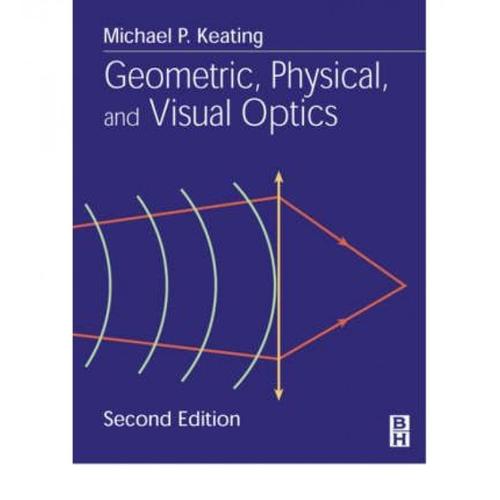热门文档
- 2022-05-26 09:53:21 杂散光抑制设计与分析_14839304
- 2022-05-26 10:19:51 《 薄膜光学与镀膜技术 》李正中
- 2021-12-28 15:41:31 现代光学基础.钟锡华.扫描版
- 2023-02-20 19:38:01 工程光学 第4版-郁道银
- 2022-05-26 15:42:36 光学设计高级讲习.160页
- 2022-05-04 23:29:15 现代光学显微镜
- 2021-08-07 15:14:37 光学仪器设计生产与装配、检校及光学冷加工新工艺新技术、质量检验标准规范实务全书
- 2022-12-04 12:49:32 现代光学镜头设计方法与实例(第2版).pdf (现代光学镜头设计方法与实例(第2版).pdf) (z-lib.org)
- 2022-04-13 00:35:13 美军标MIL-13830A 光学制图参考
- 2023-04-01 19:19:15 工程光学设计
- 2023-08-31 18:29:51 lighttools杂散光分析全部流程
- 2021-08-06 15:20:08 工业相机镜头的基础知识(课件PPT)

1、本文档共计 598 页,下载后文档不带水印,支持完整阅读内容或进行编辑。
2、当您付费下载文档后,您只拥有了使用权限,并不意味着购买了版权,文档只能用于自身使用,不得用于其他商业用途(如 [转卖]进行直接盈利或[编辑后售卖]进行间接盈利)。
3、本站所有内容均由合作方或网友上传,本站不对文档的完整性、权威性及其观点立场正确性做任何保证或承诺!文档内容仅供研究参考,付费前请自行鉴别。
4、如文档内容存在违规,或者侵犯商业秘密、侵犯著作权等,请点击“违规举报”。
2、当您付费下载文档后,您只拥有了使用权限,并不意味着购买了版权,文档只能用于自身使用,不得用于其他商业用途(如 [转卖]进行直接盈利或[编辑后售卖]进行间接盈利)。
3、本站所有内容均由合作方或网友上传,本站不对文档的完整性、权威性及其观点立场正确性做任何保证或承诺!文档内容仅供研究参考,付费前请自行鉴别。
4、如文档内容存在违规,或者侵犯商业秘密、侵犯著作权等,请点击“违规举报”。
Copyright C2002 by Butterworth-HeinemannA member of the Reed Elsevier groupAll rights reserved.publisher.Every effort has been made to ensure that the drug dosage schedules within this text are accurate and conform tostandards accepted at time of publication.However,as treatment recommendations vary in the light of continuingresearch and clinical experience,the reader is advised to verify drug dosage schedules herein with information foundon product information sheets.This is especially true in cases of new or infrequently used drugs.free paper whenever possible.Library of Congress Cataloging-in-Publication DataBritish Library Cataloguing-in-Publication DataKeating,Michael P.Geometric,physical,and visual optics1.Optics 2.OptometryI.Title617.75The publisher offers special discounts on bulk orders of this book.For information,please contact:Manager of Special SalesButterworth-Heinemann225 Wildwood AvenueWoburn,MA01801-2041Tel:781-904-2500Fax781-9042620For information on all Butterworth-Heinemann publications available,contact our World Wide Web home page at:http://www.bh.com10987654321Printed in the United States of AmericaFor all who have been supportive-especially family,friends,colleagues,teachers,and my wife Mary Jean.光学课堂光学课堂光学课光学课堂光学课堂光学课堂光学课堂光学课堂光学课堂光学课堂光学光学课光学课光学课堂光学课堂光学课光学光学课光学课堂Preface to the Second Editionhile the basic philosophy of the first edition is retained in the secondedition,there are two significant modifications.One is a change in theorder of the chapters.The chapters on introductory astigmatism,prisms,and prism in lenses (which were Chapters 15,17,and 18 in the first edition)are nowChapters 10,11,and 12.This brings the core of the basic optics material for optometrystudents together in the first 12 chapters of the book.The second significant modification follows a review of each chapter for thepurpose of either updating the information,adding pertinent material,and/orimproving (i.e.,rewriting or condensing)the material.The review has resulted inminor changes in virtually all chapters,and extensive changes in four chapters(13,16,19,and 20).The review also resulted in over 70 figure revisions from the first editionto the second edition.The first 9 chapters contain minor changes that are designed to improve thepedagogical value of the chapters.In addition Chapter 9 contains a new section onaxial magnification.Chapter 10(Astigmatism:On Axis)is not only moved forward(from Chapter 15)but has certain sections that have been rewritten,including a morecoherent presentation on the Jackson Cross Cylinder Test for cylinder power refine-ment.The chapter on prisms in lenses (old Chapter 18)has been split into two parts.The first part of the chapter(with minor revisions)is now Chapter 12.Chapter 12 alsocontains an added section on retinoscopy reflex motion.The second part of theoriginal Chapter 18(which deals with the off-axis meridians of spherocylindricallenses)is now part of Chapter 13.On the whole,this book is not a matrix optics book.However matrices are usedextensively in two chapters-13 and 16.Matrices are a simple,yet powerful tool indealing both conceptually and quantitatively with optical systems (including thehuman eye)and in dealing with the off-axis aspects of astigmatism.The use ofmatrices has lead to significant increases in our knowledge of astigmatism and thestatistics of refractive errors particularly over the last 10 years.Furthermore there arenow inexpensive hand-held calculators that automatically perform matrix calcula-tions(as well as personal computer software that does the same).So one just enters thenumbers,presses the "calculate"button,and "presto"the answer appears.Chapter 13 uses the dioptric power matrix,which is the most fundamental way ofrepresenting astigmatism in all contexts.Parts of Chapter 13 are rewritten from the oldChapters 16 and 18,while other parts are new.Chapter 16 (old 12)discusses systemmatrices.My experience over 20 years is that my optometry students consider thismaterial easier than many other aspects of optics,and in particular easier than theprincipal plane system for understanding composite optical systems including thecorrected or uncorrected human eye.The system matrix approach also has the advan-tage that it is easily extended to spherocylindrical (astigmatic)systems.




请如实的对该文档进行评分-
-
-
-
-
0 分